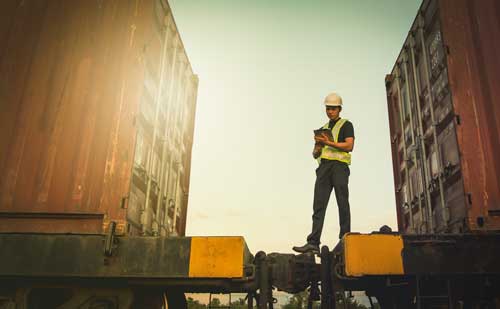GPS tracking functions via the use of a navigational device that is installed in a vehicle, and connects to the Global Positioning System, in order to determine the location of the vehicle or shipment, and track progress. The data collected via GPS can either be stored right within the navigation unit, or it can be transmitted back to a computer through an internet connection.
It will allow you to see the vehicle or person ‘s position against the backdrop of a map of the city. On mobile phones, the same type of GPS tracking is used to determine a person’s location, as well as track their movements across any given area. GPS tracking has a number of real-world applications, particularly in fleet management, where it is necessary to track the movements of a whole group of vehicles, in order to be up-to – date on their progress and overall condition.
Shipping Container Tracking Systems

A shipping container monitoring system will keep you updated on where your cargo is at sea and provide you with a variety of specifics when it is in port. Tracking any form of cargo at sea requires only that you have a number of containers or a lading number, as well as the shipping line involved. It’s very important to keep aware of where the cargo is at sea, so you can have a fair estimate of its time of arrival, so that the offloading can be completed promptly.
There are several ways of monitoring cargoes via tracking systems, first known as the Standard Container Tracking System. This setup enables you to record all movement of any container while traveling through major controls, usually when it reaches different ports.
The other approach consists of the GPS container tracking device, which is a little more advanced because it can view in real time, wherever it is in the world. It will also show important container details such as its temperature and report any sort of manipulation.
This kind of monitoring is possible because a battery pack is mounted in the container, and this battery pack follows the container everywhere so that it can report indefinitely on changing conditions. The GPS Container Tracking System offers some information about the battery status itself: temperature, distance, daytime, latitude , longitude, and details.
How Shipping Container Tracking is Conducted
Several shipping companies have been keenly interested in monitoring the progress of their cargo around the world since technology has allowed them. Several parties are interested, beginning with the shipper and shipping company customers, in the status of shipping containers. Long-distance shipments that fly across vast oceans are normally associated with great risk, and are subject to all potential weather conditions on the sea.
The entire point when installing a cargo tracking system is to keep in touch with the ship itself and to know your cargo status. The transport of cargo containers is carried out by remote satellite systems that can view satellite images of a ship container at any time. Such photos are forwarded to a base station where stakeholders can access them. That kind of monitoring device can be applied very quickly and is accessible world-wide so that any shipper can actually use it.
Many companies have established themselves now to ensure that the precise location of their fleet’s ships can be accessed in real time. There are a number of design options, for example via a GPS tracking system, satellite imaging or simply through the internet, for this information.
Once this information is obtained, a simple freight tracking system that can be easily set up can be used to inform customers of the accurate location of their cargo. Clients may go to the Internet and quickly locate the cargo or you might want to send updates to a customer’s telephone or email address to warn them automatically about the progress of the cargo.
Even in the event that an warning system is not introduced, the carrier will be able to access the full range on its website and consumers will simply go to the website of the manufacturer to verify the status of their products. The exact location of any customer cargo can be defined simply by providing the name of the cargo ship and a loading number. Understanding where and what their status is may allow customers to invest considerable resources in a certain cargo shipment.
Cargo Tracking and Security
![]()
Due to the fact that certain cargoes may have an immense consumer interest, security measures need to be introduced to make these properties more accessible while they are in transit. Many consumers want to track their assets for the duration of their life cycle so that they are completely aware of the quality of the assets at any time.
Some sophisticated tracking systems are available, sound management decisions based on information from dashboards, key performance indicators and supply chain information. Every problem with a part of the supply chain may be resolved and regularly fixed, if it is detected soon after it happens. The longer it takes to rectify some kind of supply line issue, the more likely it is for the consumer to miss a delay in shipment.
This makes it important to define all problems immediately, so that resources can be used to fix them quickly. You can have much greater visibility and understanding by using a powerful monitoring system to turn travel data into billing and insurance records. It allows the clients to monitor their payable budgets, meet audit criteria and answer end-user inquiries.
More insights can also be gained through daily reports and advanced analytical systems offered by an advanced tracking system. Whenever any problems occur, it is possible to react very rapidly, so that problems do not turn into complete, costly problems.

